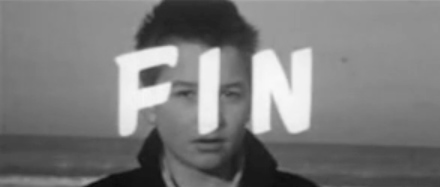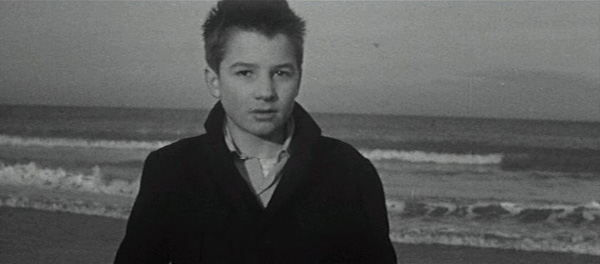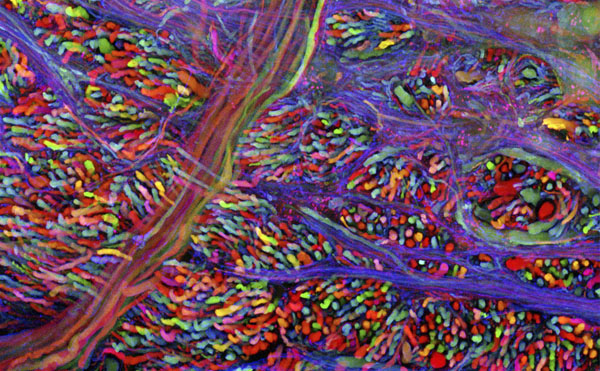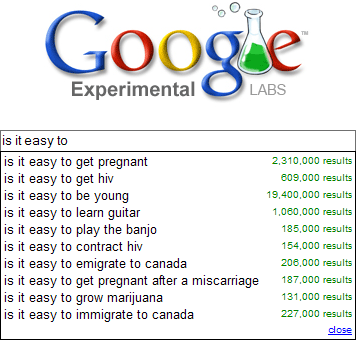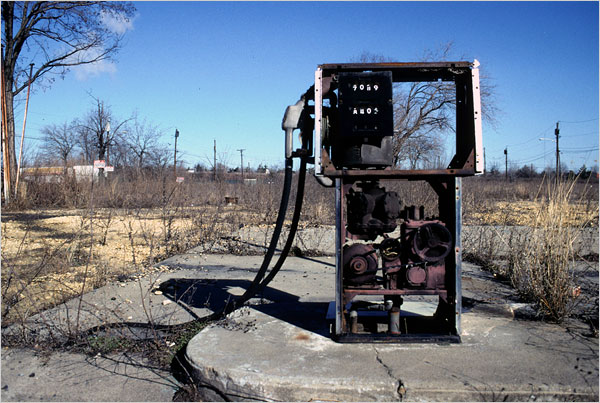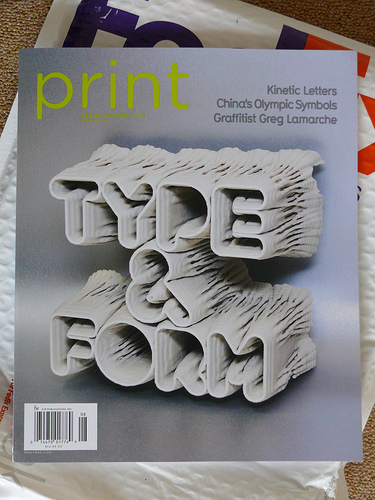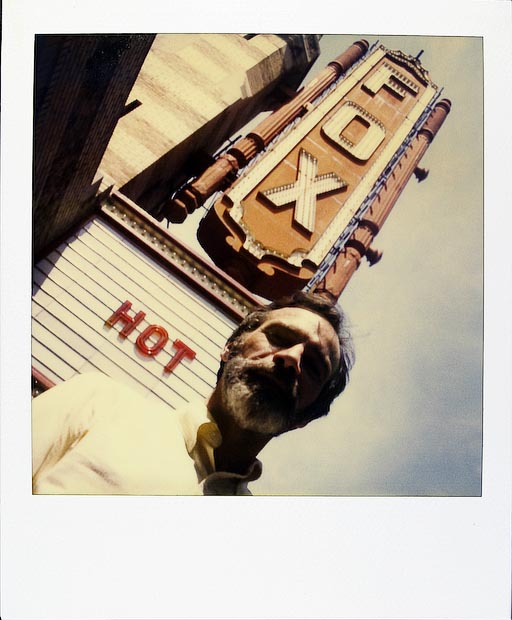The End
Fabulous collection of “The End” movie title cards.
Missing my favorite though:
Which is admittedly better pre zoom and title:
Via Daring Fireball.
The evolution of homosexuality: Gender bending
The evidence suggests that homosexual behaviour is partly genetic. Studies of identical twins, for example, show that if one of a pair (regardless of sex) is homosexual, the other has a 50% chance of being so, too. That observation, though, raises a worrying evolutionary question: how could a trait so at odds with reproductive success survive the ruthless imperatives of natural selection?Various answers have been suggested. However, they all boil down to the idea that the relatives of those who are gay gain some advantage that allows genes predisposing people to homosexual behaviour to be passed on collaterally.One proposal is that the help provided by maiden aunts and bachelor uncles in caring and providing for the children of their brothers and sisters might suffice. That seems unlikely to be the whole story (the amount of help needed to compensate would be huge), though it might be a contributory factor.
The other idea, since there is evidence that male homosexuals, at least, are more likely than average to come from large families, is that the genes for gayness bring reproductive advantage to those who have them but are not actually gay themselves. Originally, the thought was that whichever genes make men gay might make women more fecund, and possibly vice versa.
Brendan Zietsch of the Queensland Institute of Medical Research in Brisbane, Australia, and his colleagues have, however, come up with a twist on this idea. In a paper to be published soon in Evolution and Human Behavior, they suggest the advantage accrues not to relatives of the opposite sex, but to those of the same one. They think that genes which cause men to be more feminine in appearance, outlook and behaviour and those that make women more masculine in those attributes, confer reproductive advantages as long as they do not push the individual possessing them all the way to homosexuality.
Click through for more at at The Economist.
Peering into the micro world
In this Harvard University photograph released October 8th, 2008, brain cells of a laboratory mouse are shown glowing with multicolor fluorescent proteins at Harvard University in Cambridge, Mass. The Nobel prize in chemistry was awarded to two Americans and a U.S.-based Japanese scientist for research on a glowing jellyfish protein that revolutionized the ability to study disease and normal development in living organisms. (AP Photo/Harvard University, Livett-Weissman-Sanes-Lichtman)
Posted at The Big Picture.
Scenes from Antarctica
Down in Antarctica, November marks the end of spring, the beginning of austral summer, and the beginning of Antarctica’s cruise season. The Sun just rose for the first time in 6 months on September 22nd, and is now visible in the sky all the time. Recent studies in Antarctica have brought new insights into the origins of deep sea octopus species (a 30 million-year-old ancestor from Antarctic waters), volcanic contributions to disappearing antarctic ice, and the effects of increasing numbers of icebergs scouring the seafloor. Collected here are 32 photographs of Antarctica from the past several years.
Posted at The Big Picture.
Shirky on Coase, Collaboration and Here Comes Everybody
Clay Shirky, author of Here Comes Everybody: The Power of Organizing Without Organizations, talks about the economics of organizations with EconTalk host Russ Roberts. The conversation centers on Shirky’s book. Topics include Coase on the theory of the firm, the power of sharing information on the internet, the economics of altruism, and the creation of Wikipedia.
And a great bit of discussion on representative vs. direct democracy and the possibility that networks can enable direct democracy.
Via EconLog.
Sha Na Na and the Invention of the Fifties
Contemporary scholars of American cultural history have begun writing that Sha Na Na’s greatest achievement was the invention of a new American era: the “Fifties.” The whole notion of how artists can change the way a historical era is viewed, and relatively quickly, is interesting on its own.
Via Arts & Letters Daily.
DutchTek 2008
Boy those DJ's sure look happy don't they?
Here you can see a good example of the dutch "tekno" dance.
Check the girl rocking out at 4:10.
The Mother of All Maker Zen Clips
Bruce Sterling at Beyond the Beyond:
*This French guy is serenely hand-manufacturing his own vacuum tubes.
*This video is seventeen minutes long. I’d also be guessing this gentleman has invested about seventeen years in acquiring that vacuum-tube zen.
Top 15 Criteria That Define Interactive or New Media Art
The Near Future Laboratory Top-15 Criteria for New or Interactive Media Art are…15. It doesn’t work
14. It doesn’t work because you couldn’t get a hold of a 220-to-110 volt converter/110-to-220 volt converter/PAL-to-NTSC/NTSC-to-PAL scan converter/serial-to-usb adapter/“dongle” of any sort..and the town you’re in is simply not the kind of place that has/cares about such things
13. Your audience looks under/behind your table/pedestal/false wall/drop ceiling or follows wires to find out “where the camera is”
12. Someone either on their blog or across the room is prattling on about the shifting relations between producers and consumers..and mentions your project
11. Your audience “interacts” by clapping/hooting/making bird calls/flapping their arms like a duck or waving their arms wildly while standing in front of a wall onto which is projected squiggly lines
10. Your audience asks amongst themselves, “how does it work?”
9. The exhibition curators insist that you spend hours standing by your own wall text so that you can explain to attendees “how it works”
8. It’s just like using your own normal, human, perfectly good eyeballs, only the resolution sucks and the colors are really lousy..plus the heat from the CPU fan is blowing on your forehead which makes you really uncomfortable and schvitz-y
7. Someone in your audience wearing a Crumpler bag, slinging a fancy digital SLR and/or standing with their arms folded smugly says, “Yeah..yeah, I could’ve done that too..c’mon dude..some Perlin Noise? And Processing/Ruby-on-Rails/AJAX/Blue LEDs/MaxMSP/An Infrared Camera/Lots of Free Time/etc.? Pfft..It’s so easy…”
6. Someone in your audience, maybe the same guy with the Crumpler bag and digital SLR excitedly says, “Oh, dude. That should totally be a Facebook app!”
5. It’s called a “project” and not a “piece of art”
4. You saw the “project” years ago…and here it is again…now with multi-touch interaction and other fancy digital bells and Web 2.0-y whistles
3. Your audience cups their hands over various proturbances/orifices at or nearby your project attempting to confuse/interact with the camera/sensor/laser beam, even if it uses no such technology
2. There’s a noticeable preponderance of smoothly shifting red, green and blue lighting effects
1. People wonder if it wasn’t all really done in Photoshop, anyway
Via Bruce Sterling at Beyond the Beyond.
Sleep on It: How Snoozing Makes You Smarter
Robert Stickgold and Jeffrey M. Ellenbogen in Scientific American Mind
In 2007 one of us (Ellenbogen) showed that the brain learns while we are asleep. The study used a transitive inference task; for example, if Bill is older than Carol and Carol is older than Pierre, the laws of transitivity make it clear that Bill is older than Pierre. Making this inference requires stitching those two fragments of information together. People and animals tend to make these transitive inferences without much conscious thought, and the ability to do so serves as an enormously helpful cognitive skill: we discover new information (Bill is older than Pierre) without ever learning it directly.
The inference seems obvious in Bill and Pierre’s case, but in the experiment, we used abstract colored shapes that have no intuitive relation to one another, making the task more challenging. We taught people so-called premise pairs—they learned to choose, for example, the orange oval over the turquoise one, turquoise over green, green over paisley, and so on. The premise pairs imply a hierarchy—if orange is a better choice than turquoise and turquoise is preferred to green, then orange should win over green. But when we tested the subjects on these novel pairings 20 minutes after they learned the premise pairs, they had not yet discovered these hidden relations. They chose green just as often as they chose orange, performing no better than chance.
When we tested subjects 12 hours later on the same day, however, they made the correct choice 70 percent of the time. Simply allowing time to pass enabled the brain to calculate and learn these transitive inferences. And people who slept during the 12 hours performed significantly better, linking the most distant pairs (such as orange versus paisley) with 90 percent accuracy. So it seems the brain needs time after we learn information to process it, connecting the dots, so to speak—and sleep provides the maximum benefit.
Via Arts & Letters Daily.
Out of Gas
A collection of photos of old gas stations from Camilo José Vergara’s amazing Invincible Cities project, which if you haven’t seen, you need to check out.
Neuroeconomics : Do economists need brains?
In the Economist:
In the late 1990s a generation of academic economists had their eyes opened by Mr LeDoux’s and other accounts of how studies of the brain using recently developed techniques such as magnetic resonance imaging (MRI) showed that different bits of the old grey matter are associated with different sorts of emotional and decision-making activity. The amygdalas are an example. Neuroscientists have shown that these almond-shaped clusters of neurons deep inside the medial temporal lobes play a key role in the formation of emotional responses such as fear.
These new neuroeconomists saw that it might be possible to move economics away from its simplified model of rational, self-interested, utility-maximising decision-making. Instead of hypothesising about Homo economicus, they could base their research on what actually goes on inside the head of Homo sapiens.
However, not everyone is convinced. The fiercest attack on neuroeconomics, and indeed behavioural economics, has come from two economists at Princeton University, Faruk Gul and Wolfgang Pesendorfer. In an article in 2005, “The Case for Mindless Economics”, they argued that neuroscience could not transform economics because what goes on inside the brain is irrelevant to the discipline. What matters are the decisions people take—in the jargon, their “revealed preferences”—not the process by which they reach them. For the purposes of understanding how society copes with the consequences of those decisions, the assumption of rational utility-maximisation works just fine.
See also: Commodity traders superior to chimpanzees, research shows
Suicide on the Tube
Eben Harrell in Time:
At the station before Queensway, Lancaster Gate, he had broken from protocol to announce to the pranksters holding up the doors not the scripted "Mind the closing doors" but the more personal "please stop doing that or you will injure yourselves and end up in hospital." The statement had a slight, "I-know-better" air, but it was also improvised, and showed concern for passengers' well-being. I remembered this minor act of kindness as our driver addressed us on the intercom to announce the evacuation. He kept repeating: "This train is not going anywhere for some time. We have a man under the train, so the train is not going anywhere for some time." It became a sort of mantra: "I repeat: this train is not going anywhere for some time."
Via Arts & Letters Daily.
Generation. Man, now that's typography.
Late in April the super friendly people from Print Magazine commissioned me to create a cover design which would conceptually support the main feature article about “kinetic typography” of their special summer issue.
Via Bruce Sterling at Beyond the Beyond.
How to be an instant Web me-2.0 developer
The first, most basic, skill: be able to distinguish the different versions of the web.
Web versions, 1.0 to 2.0 Version Characteristics Web 1.0 Programming model equivalent to that of a slightly up-market 3270 terminal. Forms are filled in with the sequence: tab tab tab tab tab tab bonk.Web 1.00001 The beginning of the rich web experience: the first ever, primitive Javascript code fragment is written. It generates an unwanted popup, and snaffles your credit card details. Web 1.1 No visible difference from Web 1.0, apart from IE showing the text 'Javascript error' in its status bar. Web 1.2 Standard buttons are upgraded with smart 3D-looking GIFs. These react to mouseover events by bobbing up and down politely over their drop shadows. Remember when we were excited by this sort of scriptery? (None of your CSS cleverness then.) It seems so quaint now. It makes me want to cry, thinking about the good old days of ugly web pages loading slowly. Web 1.3 When you get to the home page of a V1.2 site with FireFox, it displays badly. When you go to a V1.3 website such as www.fdms.com with FireFox, it tells you to eff off and get IE. (These traditionalists in fact would seem to prefer it if you used IE4.) The age of 'you aren't good enough for our website' has begun, reaching full fruition at Web 1.5, see below. Web 1.4 Basic client-side validation added. Forms are filled in with the sequence: tab tab tab tab tab What do you mean 'invalid post code' you bloody thing?The dread phrase 'next generation of 3d smileys' is encountered for the very first time.
Via Tim Bray.
Polaroid of the Day
Via the previous item on Polaroids, I found this:
When Jamie Livingston, photographer, filmmaker, circus performer, accordian player, Mets fan, and above all, loyal friend, died on October 25th (his birthday) in 1997 at the age of 41, he left behind hundreds of bereft friends and a collection of 6,000 photographs neatly organized in small suitcases and wooden fruit crates.
Jamie took a polaroid once a day, every day, including his last, for 18 years.
This photographic diary, which he called, "Polaroid of the Day," or P.O.D., began when Jaime was a student at Bard College in Annandale-on-Hudson. The project continued when he moved to apartments in New York City including the incredible circus memorabilia-filled loft on Fulton Street, which he shared with his best friend. That loft was the site of many a Glug party, an "orphans thanksgiving," a super-8 festival of Jamie's lyrical Super-8 films, and a rollicking music jam.
Info here and the complete collection of photos is here.
Via Jason Santa Maria.
Shake It Like a Metaphorical Picture
Sometime next year, Polaroid will stop producing instant film. There have been lots of people jumping in to help save the format, and others writing some striking eulogies, as the rest of us start mourning the oncoming loss. But one thing I can’t quite shake is what Polaroid represents to me, something that will likely be on its way out the door too: the visual metaphor of a photograph.
Via Gruber at Daring Fireball.
